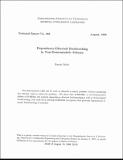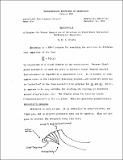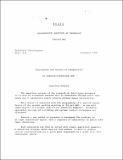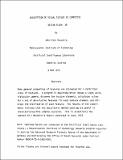Browsing Computer Science and Artificial Intelligence Lab (CSAIL) by Title
Now showing items 859-878 of 3804
-
A Denotational Semantics of CLU
(1978-05)A denotational semantics of CLU, an object-oriented language supporting data abstractions, is presented. The definition is based on Scott's lattice-theoretic approach to the theory of computation. Modules, the basic unit ... -
Denotational Semantics of Determinate and Non-Determinate Data Flow Programs
(1979-07)Among its other characteristics, a programming language should be conducive to writing modular program's, be able to express parallelism and non-determinate behavior, and it should have a cleanly formalizable semantics. ... -
Dense Depth Maps from Epipolar Images
(1996-11-01)Recovering three-dimensional information from two-dimensional images is the fundamental goal of stereo techniques. The problem of recovering depth (three-dimensional information) from a set of images is essentially the ... -
Density Reconstruction Using Arbitrary Ray Sampling Schemes
(1977-09-01)Methods for calculating the distribution of absorption densities in a cross section through an object from density integrals along rays in the plane of the cross section are well known, but are restricted to particular ... -
Dependency Directed Reasoning for Complex Program Understanding
(1979-04-01)Artificial Intelligence research involves the creation of extremely complex programs which must possess the capability to introspect, learn, and improve their expertise. Any truly intelligent program must be able to ... -
Dependency-Directed Backtracking in Non-Deterministic Scheme
(MIT Artificial Intelligence Laboratory, 1988-08)Non-deterministic LISP can be used to describe a search problem without specifying the method used to solve the problem. We show that SCHEMER, a non-deterministic dialect of SCHEME, can support dependency-directed backtracking ... -
Dependency-Directed Localization of Software Bugs
(1989-05-01)Software bugs are violated specifications. Debugging is the process that culminates in repairing a program so that it satisfies its specification. An important part of debugging is localization, whereby the smallest ... -
Derivation of an Efficient Rule System Pattern Matcher
(1989-02-01)Formalizing algorithm derivations is a necessary prerequisite for developing automated algorithm design systems. This report describes a derivation of an algorithm for incrementally matching conjunctive patterns against ... -
DERIVATOR I: A Program for Visual Inspection of Solutions to First-Order Non-Linear Differential Equations
(1963-12-01)Derivator is a PDP-1 program for examining the solutions to differential equations by inspection of a visual display of trajectories. Because fixed-point arithmetic is used (in order to maintain visual display speeds), ... -
Derived Pairs, Overlap Closures, and Rewrite Dominoes: New Tools for Analyzing Term Rewriting Systems
(1981-12)Starting from the seminal work of Knuth and Bendix, we develop several notions useful in the study of term rewriting systems. In particular we introduce the notions of "derived pairs" and "overlap closure" and show that ... -
Describing Surfaces
(1985-01-01)This paper continues our work on visual representation s of three-dimensional surfaces [Brady and Yuille 1984b]. The theoretical component of our work is a study of classes of surface curves as a source of constraint ... -
Description and Control of Manipulation by Computer-Controlled Arm
(1968-09-01)The immediate purpose of the research on Intelligent Automata is to have an autonomous machine able to understand uncomplicated commands and to manipulate simple objects without human intervention. This thesis is concerned ... -
Description and Flow Chart of the PDP-7/9 Communications Package
(1970-07)The PDP-7/9 Communications Package was written to provide data transfers between the buffer controller (PDP-7 or PDP-9) of an ESL Display Console and a host computer via a 50-kilobit serial Dataphone link. Initially, only ... -
Description and Theoretical Analysis (Using Schemata) of Planner: A Language for Proving Theorems and Manipulating Models in a Robot
(1972-04-01)Planner is a formalism for proving theorems and manipulating models in a robot. The formalism is built out of a number of problem-solving primitives together with a hierarchical multiprocess backtrack control structure. ... -
The Description of Large Systems
(1984-09-01)In this paper we discuss the problems associated with the description and manipulation of large systems when their sources are not maintained as single fields. We show why and how tools that address these issues, such ... -
A Description of the CNTOUR Program
(1966-11-01)The CNTOUR program plots an intensity relief map of an image which is read from the vidisector camera (TV-B). It may be used as a general purpose aiming, monitoring and focusing program, especially for high-contrast images, ... -
Description of Visual Texture by Computers
(MIT Artificial Intelligence Laboratory, 1973-03-09)Some general properties of textures are discussed for a restricted class of textures. A program is described which inputs a scene using vidisector camera, discerns the texture elements, calculates values for a set of ... -
Descriptions and the Specialization of Concepts
(1978-03)The OWL II System computes with expressions which describe an object from a particular viewpoint. These partial descriptions form a tree structure under the specialization operation, which preserves intensional properties. ... -
Descriptive Simulation: Combining Symbolic and Numerical Methods in the Analysis of Chemical Reaction Mechanisms
(1989-09-01)The Kineticist's Workbench is a computer program currently under development whose purpose is to help chemists understand, analyze, and simplify complex chemical reaction mechanisms. This paper discusses one module ... -
Design and Control of a Closed-Loop Brushless Torque Actuator
(1990-05-01)This report explores the design and control issues associated with a brushless actuator capable of achieving extremely high torque accuracy. Models of several different motor - sensor configurations were studied to ...




















